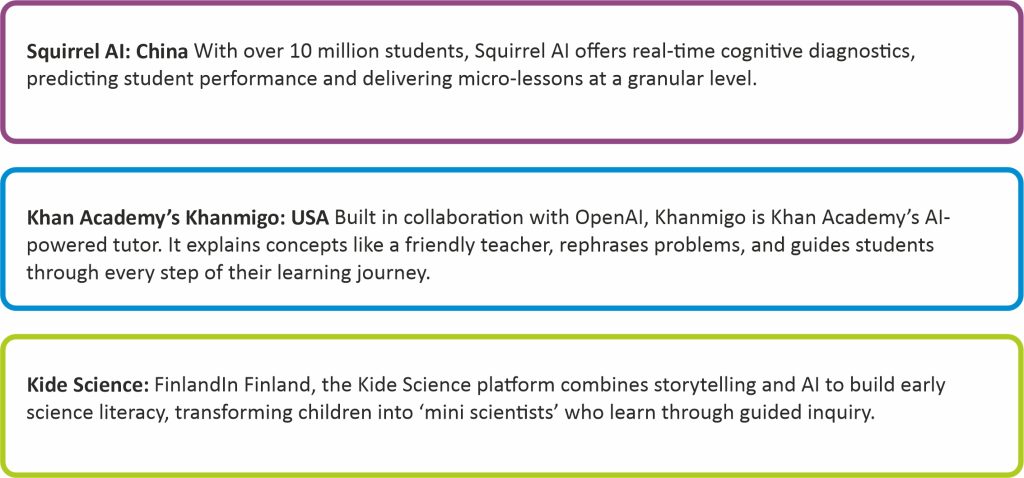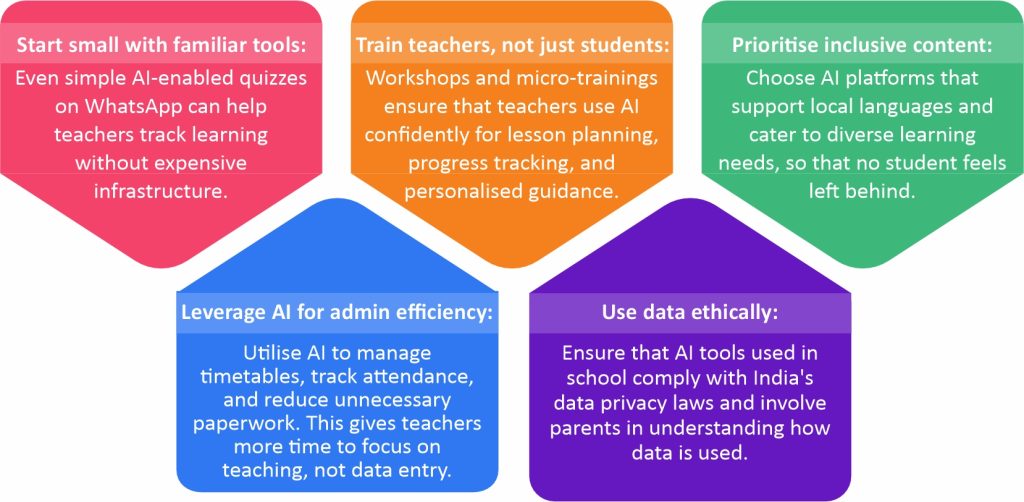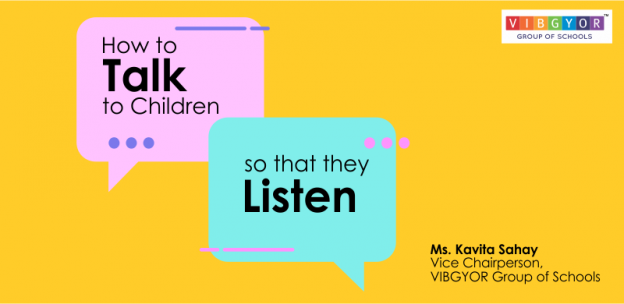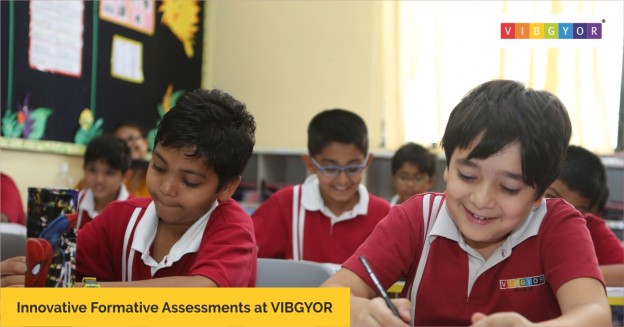![]()
Preparing young minds for an AI-driven world with education that is personal, predictive, and powerful
| In this article, you can explore: ➡️ AI in education: A new chalk and talk ➡️ Smart learning systems in action ➡️ Adaptive learning platforms: A classroom that thinks ➡️ AI and global education: Lessons from around the world ➡️ 21st-century skills and AI: Future-ready skills for smarter classrooms ➡️ From imbalance to inclusion: Bridging India’s learning divide ➡️ 5 practical steps to implement AI in schools ➡️ 5 ways to ace parenting in the age of AI |
What if your child had a teacher who never got tired, never judged, and could customise each lesson just for them?
………………………………………………………………………………………………………
Yesterday, Varun sat at the kitchen table, tapping his pencil nervously, the word “fraction” glaring at him. He then abandoned his notebook and reached for his cricket kit.
Today, the learning app he uses serves up a math problem disguised as a delectable challenge. “Slice the pizza into eight equal parts”, chimes the voice from the tablet.
The pace slows, and each correct cut earns him a virtual cheer. Varun giggles, learning in the process, without even realising it.
………………………………………………………………………………………………………
Behind the fun, artificial intelligence in classrooms is tracking his progress, identifying gaps, and quietly building his confidence.
AI in education: A new chalk and talk
Across India, AI-powered learning platforms are taking over the reins wherever traditional models fall short. In India, Mindspark by Educational Initiative (EI) has shown remarkable results.
As per the 2017 Disrupting Education? Experimental Evidence on Technology-aided Instruction in India, paper by the National Bureau of Economic Research, students who won the lottery to attend Mindspark centres scored 0.36 σ higher in maths and 0.22 σ higher in Hindi after just 4.5 months of access to the programme.
Perhaps the most significant breakthrough of AI and machine learning in education lies in their power to adapt uniquely to each student’s pace and progress.
Smart learning systems in action
As classrooms evolve, technology is becoming the link that makes learning more engaging. Smart learning systems are steadily redefining how lessons are taught and understood.

These are some of the best examples of how future-ready classrooms can look, bringing together technology and inclusivity.
………………………………………………………………………………………………………
Visual break: What does your child’s report card miss?
While traditional assessments measure performance after the test, AI-based platforms can track learning in real-time.
………………………………………………………………………………………………………
Adaptive learning platforms: A classroom that thinks
Imagine a classroom that adapts to your child’s pace. That’s the promise of adaptive learning platforms supported by intelligent tutoring systems. These digital tools shape every lesson to match a child’s pace, identify the gaps, and monitor their progress.
Here’s what makes them a game-changer:
- Understands learning cycle: Tracks speed, struggles, and strengths of students to adjust the lesson flow in real-time.
- Repeats without judgement: Revisits tough topics until the student is confident – no stress, no stigma.
- Waits till your child’s ready: Introduces new lessons only when a student truly grasps the concepts.
- Empowers teachers: Dashboards show real-time learning gaps, so that students receive help before examinations.
A study by the World Bank Group mentions that Google piloted the Read Along app in 200 villages across Uttar Pradesh. The result? 64% of participants showed an improvement in reading proficiency, and 92% of the parents noticed improvement in their child’s reading skills.
AI and global education: Lessons from around the world
Globally, countries are adapting to AI and global education strategies in unique ways, each tailoring the technology to suit their education systems.

21st-century skills and AI: Future-ready skills for smarter classrooms
The future of education with AI is less about replacing teachers and more about nurturing children with 21st-century skills and AI fluency. In a world shaped by AI and machine learning in education, students must think critically, collaborate with both peers and technology, and channel creativity into fresh ideas.
Consider Pune-based THE Labs, a not-for-profit organisation, where students from low-income communities learned how AI tools work, questioned their biases, and explored ways to train, leverage, and evaluate their outcomes.
This insightful moment highlights how AI and global education need to be grounded in awareness as much as innovation.
.……………………………………………………………………………………………………
Visual break: Should we fear AI in classrooms?
Not really. In fact, we should guide it. Since AI is a tool, its success depends on how ethically, inclusively, and intelligently we use it.
………………………………………………………………………………………………………
From imbalance to inclusion: Bridging India’s learning divide
AI in education has the potential to close India’s toughest gaps, especially where student-teacher ratios are high. Platforms like ConveGenius’s personalised adaptive learning (PAL) are active across 16 states, reaching over half a million children with real-time, multilingual instruction customised to each student’s pace.
In Nagpur, India’s first AI-powered Anganwadi, fitted with VR headsets, smartboards, and interactive digital tools, has more than doubled attendance, turning early childhood centres into lively, engaging spaces.
By adapting across languages, learning levels, and local realities, personalised learning with AI is pushing Indian classrooms beyond one-size-fits-all teaching, toward a more equitable, welcoming, and scalable model for all learners.
5 practical steps to implement AI in schools
For schools, the value of AI lies in thoughtful use. These five moves make AI in education practical, inclusive, and impactful:

5 ways to ace parenting in the age of AI
As a parent, you shape how your child experiences AI in education and learning. By staying engaged, setting boundaries, and reinforcing lessons at home, they can ensure that technology becomes a supportive guide rather than a distraction.
- Be curious, not cautious
Curiosity builds trust and shared learning. Ask your child to demonstrate how AI tools work and what new they have discovered.
- Set screen-time boundaries
Differentiate between active learning and passive scrolling. Limit passive screen time and encourage your kids to use interactive learning apps instead.
- Encourage learning in everyday life
If AI explains a science concept in English, repeat it in your native language, or connect it to local experiences, which strengthens personalised learning with AI and cultural relevance.
- Point out when something feels off
If the app is too complex, you must act immediately in the interest of your little one. AI tools should support your child, not stress them.
- Celebrate wins together
When an app gives positive feedback, share it with your child and reinforce it in their daily learning process. Recognition boosts motivation and self-worth.
The promise of AI in education is not about replacing human touch, but strengthening its reach and resonance. With AI-powered learning, children gain confidence through personalised pathways, teachers get clarity with real-time insights, and parents gain reassurance about their child’s learning progress. Yet, no algorithm can replicate wisdom, empathy, or values; these remain profoundly human. If guided responsibly, the future of education with AI can deliver not only speed and scale, but also classrooms that nurture fairness, creativity, and compassion, spaces where learning becomes smarter, kinder, and truly transformative for every child.



